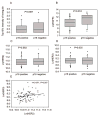Heregulin and HER3 are prognostic biomarkers in oropharyngeal squamous cell carcinoma
- PMID: 26195293
- PMCID: PMC4592409
- DOI: 10.1002/cncr.29549
Heregulin and HER3 are prognostic biomarkers in oropharyngeal squamous cell carcinoma
Abstract
Background: Although heregulin and human epidermal growth factor receptor 3 (HER3) are frequently expressed at high levels in patients with head and neck cancer, their prognostic value remains unclear. The authors explored the prognostic significance of heregulin/HER3 expression in patients with oropharyngeal squamous cell carcinoma (OPSCC), taking into account other HER family members as well as p16 status.
Methods: Ninety-six primary tumor specimens from patients with OPSCC were retrospectively collected and analyzed for heregulin messenger RNA (mRNA) using in situ hybridization and for HER3, epidermal growth factor receptor, and human epidermal growth factor receptor 2 (HER2) using quantitative immunohistochemistry. Heregulin and HER3 mRNA levels were also examined among different tumor types using The Cancer Genome Atlas database.
Results: High heregulin mRNA (> the median) correlated significantly with poor overall survival (OS) (hazard ratio [HR], 8.48; 95% confidence interval [95% CI], 2.17-33.17 [P =.002]) but not disease-free survival (HR, 1.52; 95% CI, 0.64-3.65 [P =.341]) in patients with OPSCC. Heregulin mRNA correlated negatively with OS in both patients with p16-positive (P =.049) and p16-negative (P =.091) OPSCC on univariate analysis. High HER3 (> the median) also correlated with poor OS (HR, 4.68; 95% CI, 1.47-14.90 [P =.009]) on multivariate analysis. Epidermal growth factor receptor levels independently correlated with disease-free survival (P =.025) and inversely correlated with p16 status (P =.012). In addition, The Cancer Genome Atlas data demonstrated that head and neck squamous cell carcinoma exhibits higher heregulin expression compared with other solid tumor types examined.
Conclusions: High heregulin mRNA and high HER3 protein levels were found to independently correlate with poor OS in patients with OPSCC. These data support targeting HER3 in patients with heregulin-high OPSCC and warrant further clinical investigation.
Keywords: epidermal growth factor receptor (EGFR); head and neck cancer; heregulin; human epidermal growth factor receptor 3 (HER3); human papillomavirus.
© 2015 American Cancer Society.
Conflict of interest statement
This study was funded in part by Merrimack Pharmaceuticals. G. Garcia and G. MacBeath are employees and stockholders of Merrimack Pharmaceuticals.
Figures




References
Publication types
MeSH terms
Substances
Grants and funding
LinkOut - more resources
Full Text Sources
Other Literature Sources
Medical
Research Materials
Miscellaneous

